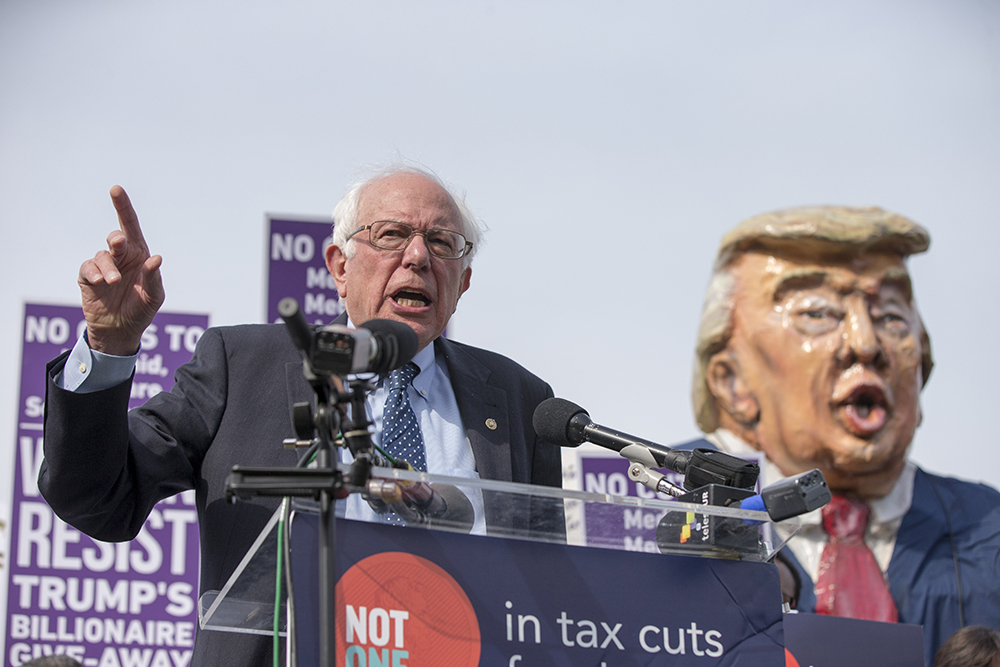
United States Senator Bernie Sanders speaks during a rally led by United States congressional Democrats against President Donald J. Trump's proposed tax plan outside the U.S. Capitol in Washington, D.C. in 2017
We live in an apparent paradox: trust in institutions is dropping, while trust in individuals at those institutions seems to be on the rise. According to an ongoing study from the Pew Research Center, trust in the federal government remains near historic lows, continuing a longstanding trend across the U.S. populace in declining trust. As a 2017 Pew report noted, “Only 18% of Americans today say they can trust the government in Washington to do what is right ‘just about always’ (3%) or ‘most of the time’ (15%). When the National Election Study began asking about trust in government in 1958, about three-quarters of Americans trusted the federal government to do the right thing almost always or most of the time.”
On the other hand, trust in certain politicians has reached historic highs, breaking the usual norms of political credibility. While Donald Trump’s national approval rating is often touted as well below that of Obama’s—at 39%, it’s lower than that of almost all U.S. presidents at the equivalent point in their tenure, according to Gallup—less discussed is the fact that he commands 89% approval among Republicans, a number on par with Inauguration Day 2017. In other words, this number has remained steady for years, through all the scandals and headlines, and despite, as a Shorenstein Center report pointed out, receiving historically negative coverage.
This phenomenon is not limited to Trump. On the left, Gallup found that Bernie Sanders commands nearly 80% approval ratings among Democratic supporters. What gives? Andy Warhol’s misattributed assertion that one day everyone will have their 15 minutes of fame now seems predictive of the internet and predictive of this moment, when we have a reality television star in the White House and others who seem ever present as television and online personalities. Speaking on NPR, curator Sherri Geldin commented on Warhol’s relevance in the digital age, saying “he really foretold our complete desire to kind of be everywhere at all times and to make of ourselves celebrity.”
What seems like a contradiction is, in fact, consistent with the larger trends. While authoritative trust decreases, trust doesn’t disappear entirely. Humans, after all, have to function, and we need some way to understand how to make decisions. The concept of a low-trust society has a long history, starting with Francis Fukuyama’s book, “Trust,” and it’s been studied and critiqued by many scholars. Fukuyama defines it thus: “trust arises when a community shares a set of moral values in such a way as to create expectations of regular and honest behaviour.” In other words, trust is built from a certain level of societal consensus. In lower-trust societies, this notion of consensus goes out the window, as family units, neighbors, and trusted networks become more essential to people’s livelihoods than larger institutions. In the Western world, as trust in institutions drops, we’re seeing a shift in how trust works: from authority to affiliation, however an individual defines that.
In my new book “Memes to Movements: How the World’s Most Viral Media Is Changing Social Protest and Power” (published Jan. 8 by Beacon Press), I explore the notion of networked journalism, an idea developed by CUNY professor Jeff Jarvis to highlight the fact that journalists must now operate with and within online networks to do their jobs more efficiently. During his time as a Nieman Visiting Fellow, Hong Qu outlined some of these dynamics in his study of how the story of the Boston Marathon bombing reverberated from social media, through blogs and local media and into national discourse:
There is a reflexive reaction to pit emergent social media behavior against the traditional journalistic practices and norms. This defensive posture is counterproductive for both sides. Rather than pointing out flaws in order to uphold one model over the other, we should appreciate the interplay between them with a sense of symbiotic dependence that ultimately produces a more participatory, accurate and compelling news cycle.
What’s important to recognize is that journalism within networks does not simply mean doing the same thing in a networked way. Rather, working in a networked environment requires understanding the people, norms, and cultural practices of the communities within. Hosting a Reddit AMA, for example, carries fundamentally different social norms from posting a tweetstorm. People in power, from Trump to U.S. Rep. Alexandria Ocasio-Cortez, are starting to adapt their communications for a networked world. In an article for Fast Company, Ray Drainville and I argued that where Trump has mastered the art of Twitter, combining strong emotions, all caps posts, and retweets of his fans and followers, Ocasio-Cortez has utilized Instagram to its fullest, appealing to a youthful base through creative disappearing stories, fun stickers, selfie videos, and even impromptu polls.
Both leaders, despite their contrasting politics and backgrounds, project authenticity, a phenomenon that, like art and pornography, is difficult to define and yet recognizable when you see it. I tend to think of it in the context of the internet as the impression (and I emphasize the word impression here) that one is not performing one’s self online. Love or hate Trump or Ocasio-Cortez (or both), it’s impossible to deny that they both project the sense that they aren’t traditional politicians or too polished. They both come across as very much themselves, whether that’s the former ranting about immigrants on television or that’s the latter cooking up ramen in an Instant Pot and pushing for a higher tax rate for the wealthy.
What’s even more important to recognize is that none of this is new, and that the crisis of trust in journalism yields opportunities for new, innovative practices that recognize the new dynamics of trust in a networked environment. Indeed, while it can be tempting to blame social media for these new dynamics, the trend began long before social media. Both Roosevelt and Eisenhower adapted for the new media of their day—radio and television, respectively—in an effort to bypass journalists and speak directly to the American public.
Traditional journalists and media observers reacted in a way that might sound familiar today: they bemoaned both technologies for valorizing style over substance, and personality over politics. As Wesleyan University political scientist Sigmund Neumann observed about radio in the 1930s: “It dramatizes news. It kills every criticism. It reaches everyone, even and especially the illiterate.” The good news is this: over time, in the case of both radio and television, news media adapted. While there are plenty of negative examples, we now have a plethora of examples of quality journalism, from NPR to podcasts, from PBS discussions to Netflix documentaries, that leverage the strengths of these media while still fulfilling their obligations to inform and inspire the public.
Adapting for the new age of networked authenticity over broadcast authority will not be easy. It is no longer possible to have a single most trusted man in America, à la Walter Cronkite, nor, might I add, was he always that great, given the massive gender and racial disparities of Cronkite’s time that were not reflected in mainstream news. As I wrote recently in Nieman Lab, we can no longer take consensus for granted. The broad diversity of media that people have access to and a shift to networks of affiliation as the default mode of trust means that journalists must adapt to a seemingly infinite variety of norms and networks. From the algorithmic feeds of YouTube and TikTok to the forums-based discourse of Reddit and WhatsApp groups to the livestream-oriented platforms of Twitch and Instagram, people can potentially receive information and formulate their opinions from countless sources.
The ability to operate across a multitude of networks and project authenticity within these communities requires a level of resources and sustainability that are difficult to achieve in the context of countless layoffs and journalism’s entire business model being called into question. Additionally, in a partisan media environment where polarization makes discourse across the aisle even more difficult than before, it is not clear how or whether broad trust in media can be achieved. The challenges indeed seem dire.
The alternative to not facing these challenges, however, is even more dire: ceding our multitude of digital public spaces entirely to politicians, propagandists, trolls, extremists, and entertainers. Our digital spaces need journalists more than ever.

